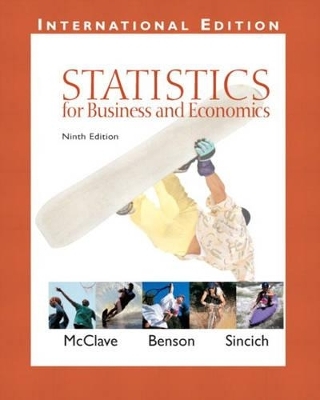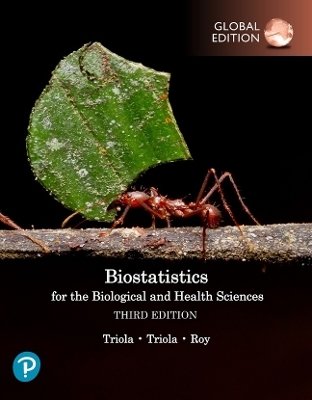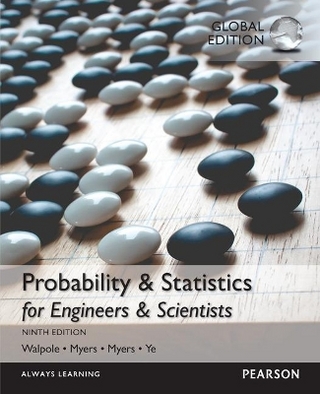
Statistics for Business and Economics
Pearson
978-0-13-124698-0 (ISBN)
- Titel erscheint in neuer Auflage
- Artikel merken
For a one- or two-term course in business statistics.
Designed for students with a background in basic algebra, this best-selling introduction to business statistics emphasizes inference; data collection and analysis are covered extensively, as needed, to evaluate the reported results of statistical studies and to make good business decisions. The authors stress the development of statistical thinking—the assessment of credibility and value of the inferences made from data—both by those who consume and those who produce the information. Numerous case studies, examples, and exercises all draw on real business situations and recent economic events.
1. Statistics, Data, and Statistical Thinking.
1.1 The Science of Statistics
1.2 Types of Statistical Applications
1.3 Fundamental Elements of Statistics
1.4 Processes (Optional)
1.5 Types of Data
1.6 Collecting Data
1.7 The Role of Statistics in Managerial Decision-Making
Statistics in Action: A "20/20" View of Survey Results - Fact or Fiction?
Using Technology: Creating and Listing Data in SPSS, MINITAB, and EXCEL
2. Methods for Describing Sets of Data.
2.1 Describing Qualitative Data
2.2 Graphical Methods for Describing Quantitative Data
2.3 Summation Notation
2.4 Numerical Measures of Central Tendency
2.5 Numerical Measures of Variability
2.6 Interpreting the Standard Deviation
2.7 Numerical Measures of Relative Standing
2.8 Methods for Detecting Outliers (Optional)
2.9 Graphing Bivariate Relationships (Optional)
2.10 The Time Series Plot (Optional)
2.11 Distorting the Truth with Descriptive Techniques
Statistics In Action: Characteristics of Physicians who Use or Refuse Ethics Consultation
Using Technology: Describing Data using SPSS, MINITAB, and EXCEL/PHStat2
APPLYING STATISTICS TO THE REAL WORLD: THE KENTUCKY MILK CASE C PART I (A Case Covering Chapters 1 and 2)
3. Probability.
3.1 Events, Sample Spaces, and Probability
3.2 Unions and Intersections
3.3 Complementary Events
3.4 The Additive Rule and Mutually Exclusive Events.
3.5 Conditional Probability
3.6 The Multiplicative Rule and Independent Events
3.7 Random Sampling
3.8 Bayes' Rule (Optional)
Statistics In Action: Lottery Buster!
Using Technology: Generating a Random Sample Using SPSS, MINITAB, and EXCEL/PHStat2
4. Discrete Random Variables.
4.1 Two Types of Random Variables
4.2 Probability Distributions for Discrete Random Variables
4.3 Expected Values of Discrete Random Variables
4.4 The Binomial Random Variable
4.5 The Poisson Random Variable (Optional)
4.6 The Hypergeometric Random Variable (Optional)
Statistics in Action: Probability in a Reverse Cocaine Sting
Using Technology: Binomial, Poisson, and Hypergeometric Probabilities using SPSS, MINITAB, and EXCEL/PHStat2
5. Continuous Random Variables
5.1Continuous Probability Distributions
5.2The Uniform Distribution (Optional)
5.3The Normal Distribution
5.4Descriptive Methods for Assessing Normality
5.5Approximating a Binomial Distribution with a Normal Distribution
5.6The Exponential Distribution (Optional)
Statistics in Action: Super Weapons Development - Optimizing the Hit Ratio
Using Technology: Cumulative Probabilities and Normal Probability Plots using SPSS, MINITAB, and EXCEL/PHStat2
6. Sampling Distributions
6.1The Concept of Sampling Distributions
6.2Properties of Sampling Distributions: Unbiasedness and Minimum Variance (Optional)
6.3The Sampling Distribution of and the Central Limit Theorem
Statistics in Action: The Insomnia Pill
Using Technology: Simulating a Sampling Distribution using MINITAB and EXCEL/PHStat2
APPLYING STATISTICS TO THE REAL WORLD: THE FURNITURE FIRE CASE (A Case Covering Chapters 3-6)
7. Inferences Based on a Single Sample: Estimation with Confidence Intervals
7.1Large-Sample Confidence Interval for a Population Mean
7.2Small-Sample Confidence Interval for a Population Mean
7.3Large-Sample Confidence Interval for a Population Proportion
7.4Determining the Sample Size
7.5Finite Population Correction for Simple Random Sampling (Optional)
7.6Sample survey Designs (Optional)
Statistics in Action: Scallops, Sampling, and the Law
Using Technology: Confidence Intervals using SPSS, MINITAB and EXCEL/PHStat2
8. Inferences Based on a Single Sample: Tests of Hypothesis
8.1The Elements of a Test of Hypothesis
8.2Large-Sample Test of Hypothesis About a Population Mean
8.3Observed Significance Levels: p-Values
8.4Small-Sample Test of Hypothesis About a Population Mean
8.5Large-Sample Test of Hypothesis About a Population Proportion
8.6Calculating Type II Error Probabilities: More About _ (Optional)
8.7Test of Hypothesis About a Population Variance (Optional)
Statistics in Action: Diary of a Kleenex User
Using Technology: Tests of Hypotheses using SPSS, MINITAB and EXCEL/PHStat2
9. Inferences Based on a Two Samples: Confidence Intervals and Tests of Hypotheses
9.1Comparing Two Population Means: Independent Sampling
9.2Comparing Two Population Means: Paired Difference Experiments
9.3Comparing Two Population Proportions: Independent Sampling
9.4Determining the Sample Size
9.5Comparing Two Population Variances: Independent Sampling
Statistics in Action: The Effect of Self-Managed Work Teams on Family Life
Using Technology: Two-Sample Inferences using SPSS, MINITAB and EXCEL/PHStat2
APPLYING STATISTICS TO THE REAL WORLD: THE KENTUCKY MILK CASE C PART II (A Case Covering Chapters 7-9)
10. Design of Experiments and Analysis of Variance
10.1Elements of a Designed Experiment
10.2The Completely Randomized Design
10.3Multiple Comparisons of Means
10.4The Randomized Block Design (Optional)
10.5Factorial Experiments
Statistics in Action: The Ethics of Downsizing
Using Technology: Analysis of Variance using SPSS, MINITAB and EXCEL/PHStat2
11. The Chi-Square Test and the Analysis of Contingency Tables
11.1Categorical Data and the Multinomial Distribution
11.2Testing Category Probabilities: One-Way Table
11.3Testing Category Probabilities: Two-Way (Contingency) Table
11.4A Word of Caution About Chi-Square Tests
Statistics in Action: A Study of Coupon Users—Mail versus the Internet
Using Technology: Chi-Square Analyses using SPSS, MINITAB and EXCEL/PHStat2
APPLYING STATISTICS TO THE REAL WORLD: DISCRIMINATION IN THE WORKPLACE (A Case Covering Chapters 10-11)
12. Simple Linear Regression
12.1Probabilistic Models
12.2Fitting the Model: The Least Squares Approach
12.3Model Assumptions
12.4An Estimator of _2
12.5Making Inferences About the Slope _1
12.6The Coefficient of Correlation
12.7The Coefficient of Determination
12.8Using the Model for Estimation and Prediction
12.9A Complete Example
Statistics in Action: Can "Dowsers" Really Detect Water?
Using Technology: Simple Linear Regression using SPSS, MINITAB and EXCEL/PHStat2
13. Multiple Regression and Model Building
13.1Multiple Regression Models
13.2The First-Order Model: Estimating and Interpreting the _-Parameters
13.3Model Assumptions
13.4Inferences About the Individual _ Parameters
13.5Checking the Overall Utility of a Model
13.6Using the Model for Estimation and Prediction
13.7Model Building: Interaction Models
13.8Model Building: Quadratic and other Higher-Order Models
13.9Model Building: Qualitative (Dummy) Variable Models
13.10Model Building: Models with both Quantitative and Qualitative Variables (Optional)
13.11Model Building: Comparing Nested Models (Optional)
13.12Model Building: Stepwise Regression (Optional)
13.13Residual Analysis: Checking the Regression Assumptions
13.14Some Pitfalls: Estimability, Multicollinearity, and Extrapolation
Statistics in Action: Bid-Rigging in the Highway construction Industry
Using Technology: Multiple Regression using SPSS, MINITAB and EXCEL/PHStat2
APPLYING STATISTICS TO THE REAL WORLD: THE CONDO SALES CASE (A Case Covering Chapters 12-13)
14. Methods for Quality Improvement
14.1Quality, Processes, and Systems
14.2Statistical Control
14.3The Logic of Control Charts
14.4A Control Chart for Monitoring the Mean of a Process: The -Chart
14.5A Control Chart for Monitoring the Variation of a Process: The R-Chart
14.6A Control Chart for Monitoring the Proportion of Defectives Generated by a Process: The p-Chart
14.7Diagnosing the Causes of Variation (Optional)
14.8Capability Analysis (Optional)
Statistics in Action: Testing Jet Fuel Additive for Safety
Using Technology: Control Charts using SPSS, MINITAB and EXCEL/PHStat2
15. Time Series: Descriptive Analyses, Models, and Forecasting
15.1Descriptive Analysis: Index Numbers
15.2Descriptive Analysis: Exponential Smoothing
15.3Time Series Components
15.4Forecasting: Exponential Smoothing
15.5Forecasting Trends: The Holt-Winters Model (Optional)
15.6Measuring Forecast Accuracy: MAD and RMSE
15.7Forecasting Trends: Simple Linear Regression
15.8Seasonal Regression Models
15.9Autocorrelation and the Durbin-Watson Test
Statistics In Action: Forecasting the Monthly Sales of a New Cold Medicine
Using Technology: Forecasting using SPSS, MINITAB and EXCEL/PHStat2
APPLYING STATISTICS TO THE REAL WORLD: THE GASKET MANUFACTURING CASE (A Case Covering Chapters 14-15)
16. Nonparametric Statistics
16.1Single Population Inferences: The Sign Test
16.2Comparing Two Populations: The Wilcoxon Rank Sum Test for Independent Samples
16.3Comparing Two Populations: The Wilcoxon Signed Rank Test for the Paired Difference Experiment
16.4The Kruskal-Wallis H-Test for a Completely Randomized Design
16.5The Friedman Fr - Test for a Randomized Block Design (Optional) 16.6Spearman's Rank Correlation Coefficient
Statistics in Action: Deadly Exposure—Agent Orange and Vietnam Vets
Using Technology: Nonparametric Analyses using SPSS, MINITAB and EXCEL/PHStat2
Appendix ABasic Counting Rules
Appendix BTables
Table IRandom Numbers
Table IIBinomial Probabilities
Table IIIPoisson Probabilities
Table IVNormal Curve Areas
Table VExponentials
Table VICritical Values of t
Table VIICritical Values of _2
Table VIIIPercentage Points of the F Distribution, _=.10
Table IX Percentage Points of the F Distribution, _=.05
Table X Percentage Points of the F Distribution, _=.025
Table XI Percentage Points of the F Distribution, _=.01
Table XIICritical Values of TL and TU for the Wilcoxon Rank Sum Test: Independent Samples
Table XIIICritical Values of T0 in the Wilcoxon Paired Difference Signed Rank Test
Table XIVCritical Values of Spearman's Rank Correlation Coefficient
Appendix CCalculation Formulas for Analysis of Variance Short Answers to Selected Odd-Numbered Exercises Index
| Erscheint lt. Verlag | 13.5.2004 |
|---|---|
| Sprache | englisch |
| Maße | 206 x 251 mm |
| Gewicht | 2138 g |
| Themenwelt | Mathematik / Informatik ► Mathematik ► Statistik |
| ISBN-10 | 0-13-124698-4 / 0131246984 |
| ISBN-13 | 978-0-13-124698-0 / 9780131246980 |
| Zustand | Neuware |
| Haben Sie eine Frage zum Produkt? |
aus dem Bereich

